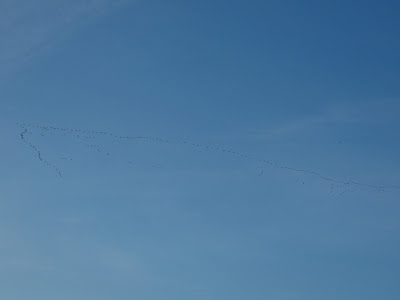Pink-footed Geese have been a feature the last week, skeins flying over Hull in their daily commute between their Humber roosts to fields where they feed. Surprisingly, I hadn't had Pinkfoot at the patch, so this morning I headed there in time for 'pink o'clock'. Right on cue, the first skein passed over at 8:05, flying due East. Skein after skein flew over, the largest 242 individuals! I counted a total of 814 over, but there surely I missed many. Last year, Pink-footed geese stayed in the Humber over winter in numbers and their daily movements were one of the highlights of the autumn, and it looks like this year we are going to have a repeat.
The largest skeins of 214 individuals.
Another group heading East.
I do the usual walk around the patch. A Bullfinch by the Guelder Rose and a Blackbird feeding on haws are highlights. The alarm calls of gulls rise every now and then, I scan around, but I see nothing.
Blackbird eating hawthorn berries.
It is low tide at the River Hull. As I count some Black-headed gulls on the water's edge, three Redshank arrive calling, the first in the patch for a while. Two of them are squabbling, maybe trying to defend a patch of mud.
A Herring Gull and Black-headed Gulls. Two Common Gulls seen, but the Lesser Black-backed gulls seem to have gone.
Redshank.
Squabbling Redshanks.
Two Cormorants flew over earlier. There is now one fishing in the river, it emerges gulping down, it's neck enlarged with it's capture.Cormorant just after swallowing prey.
Magpie with the Reckitt tower in the background.This was one of the highlights this morning, an adult pair, landing atop the tower after flying about, calling, flushing the gulls and feral pigeons.











No comments:
Post a Comment